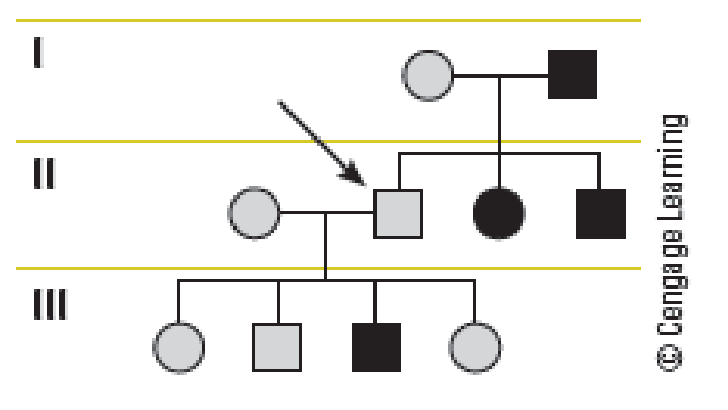
Human Heredity: Principles and Issues
11th Edition
ISBN: 9781305683952
Author: Michael Cummings
Publisher: Cengage Learning US
expand_more
expand_more
format_list_bulleted
Concept explainers
Textbook Question
Chapter 4, Problem 8QP
Analysis of Autosomal Recessive and Dominant Traits
In the following pedigree, assume that the father of the proband is homozygous for a rare trait. What pattern of inheritance is consistent with this pedigree? In particular, explain the

Expert Solution & Answer
Trending nowThis is a popular solution!
Learn your wayIncludes step-by-step video

schedule06:58
Students have asked these similar questions
What is the difference between Uniporters, Symporters and Antiporters? Which of these are examples of active transport?
What are coupled transporters?
What are “domains” and how do they aid in protein function?
Chapter 4 Solutions
Human Heredity: Principles and Issues
Ch. 4.3 - Does a pedigree drawn from the available...Ch. 4.3 - Prob. 2EGCh. 4.7 - Did the fact that Prince Albert and Queen Victoria...Ch. 4.7 - Which members of the pedigree could have been...Ch. 4 - Pedigree analysis is a fundamental tool for...Ch. 4 - Pedigree analysis is a fundamental tool for...Ch. 4 - Pedigree analysis is a fundamental tool for...Ch. 4 - Pedigree Analysis Is a Basic Method in Human...Ch. 4 - Pedigree Analysis Is a Basic Method in Human...Ch. 4 - Pedigree Analysis Is a Basic Method in Human...
Ch. 4 - Pedigree Analysis Is a Basic Method in Human...Ch. 4 - Analysis of Autosomal Recessive and Dominant...Ch. 4 - Analysis of Autosomal Recessive and Dominant...Ch. 4 - Use the following information to respond to the...Ch. 4 - Analysis of Autosomal Recessive and Dominant...Ch. 4 - Analysis of Autosomal Recessive and Dominant...Ch. 4 - A proband female with an unidentified disease...Ch. 4 - Analysis of Autosomal Recessive and Dominant...Ch. 4 - Prob. 12QPCh. 4 - Analysis of Autosomal Recessive and Dominant...Ch. 4 - Analysis of Autosomal Recessive and Dominant...Ch. 4 - Analysis of X-Linked Dominant and Recessive Traits...Ch. 4 - Prob. 16QPCh. 4 - Analysis of X-Linked Dominant and Recessive Traits...Ch. 4 - Analysis of Autosomal Recessive and Dominant...Ch. 4 - Analysis of X-Linked Dominant and Recessive Traits...Ch. 4 - Analysis of X-Linked Dominant and Recessive Traits...Ch. 4 - Analysis of X-Linked Dominant and Recessive Traits...Ch. 4 - Analysis of X-Linked Dominant and Recessive Traits...Ch. 4 - Prob. 23QPCh. 4 - Prob. 24QPCh. 4 - Variations in Phenotype Expression Define...Ch. 4 - Prob. 26QPCh. 4 - Variations in Phenotype Expression A genetic...Ch. 4 - Variations in Phenotype Expression Explain how...
Knowledge Booster
Learn more about
Need a deep-dive on the concept behind this application? Look no further. Learn more about this topic, biology and related others by exploring similar questions and additional content below.Similar questions
- What are intrinsically disordered proteins, and how might they be useful for a living system?arrow_forwardWhat are Amyloid Fibrils? What biological functions are these known to perform?arrow_forwardHow do histamine and prostaglandins help in the mobilization of leukocytes to an injury site? What are chemotactic factors? How do they affect inflammation process?arrow_forward
- Compare and contrast neutrophils and macrophages. Describe two ways they are different and two ways they are similar.arrow_forwardDescribe the effects of three cytokines (not involved in the initial inflammation response). What cells release them?arrow_forwardDescribe activation of helper T cells or cytotoxic T cellsarrow_forward
- Compare and contrast MHC 1 and MHC 2. Describe two way they are different and two ways they similar including how they are used in antigen presentation.arrow_forwardDescribe two antimicrobial properties of the skin.arrow_forwardDescribe how the inflammation response starts including the sentinel cells and the chemicals involved. How do pathogens trigger the response particularly in the skin?arrow_forward
- How does complement promote the immune response? Describe three waysarrow_forwardWhich of the following is not a possible mechanism for autoimmunity? Select one: A. Abnormal expression of MHC II molecules in non-antigen-presenting cells B. Activation of polyclonal B cells C. Polymorphism of HLA alleles D. Molecular mimicry E. Release of sequestered antigensarrow_forwardWRITTEN WORK 3: NON-MENDELIAN GENETICS Part A: Complete the Punnett square and calculate for the probability of genotype and phenotype. i i Genotype: Phenotype: 08:55arrow_forward
arrow_back_ios
SEE MORE QUESTIONS
arrow_forward_ios
Recommended textbooks for you
 Human Heredity: Principles and Issues (MindTap Co...BiologyISBN:9781305251052Author:Michael CummingsPublisher:Cengage Learning
Human Heredity: Principles and Issues (MindTap Co...BiologyISBN:9781305251052Author:Michael CummingsPublisher:Cengage Learning

Human Heredity: Principles and Issues (MindTap Co...
Biology
ISBN:9781305251052
Author:Michael Cummings
Publisher:Cengage Learning
How to solve genetics probability problems; Author: Shomu's Biology;https://www.youtube.com/watch?v=R0yjfb1ooUs;License: Standard YouTube License, CC-BY
Beyond Mendelian Genetics: Complex Patterns of Inheritance; Author: Professor Dave Explains;https://www.youtube.com/watch?v=-EmvmBuK-B8;License: Standard YouTube License, CC-BY